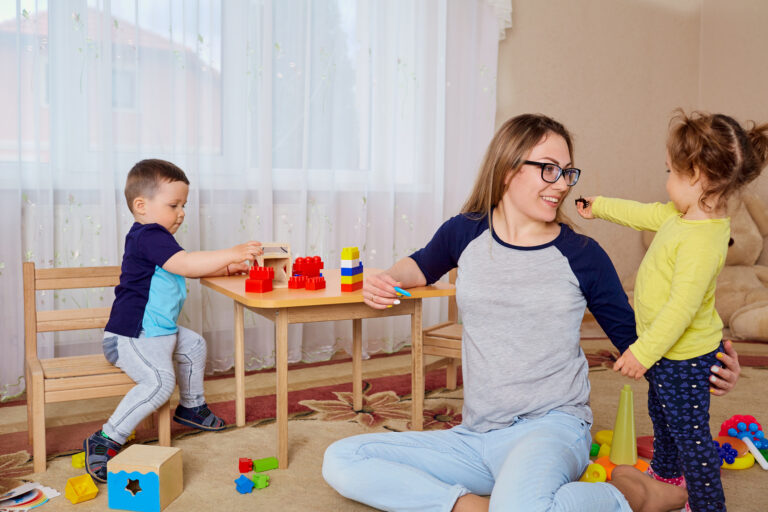Children who grow up in a safe and supportive environment are more likely to develop positive behaviours and thrive emotionally. For children living in homes that provide therapeutic care, this nurturing environment becomes even more crucial. Creating a therapeutic environment involves establishing a space that promotes physical safety and comfort, while also encouraging positive behaviours and emotional well-being. In this blog post, we will explore the importance of a therapeutic environment in children’s homes and discuss various strategies to support and foster positive behaviours. From arranging furniture and décor to incorporating therapeutic elements into daily routines, we will delve into the practical ways in which caregivers can create an environment that supports the growth and development of children in their care. Additionally, we will explore the significance of effective communication in building trust and creating a supportive atmosphere. Join us as we explore the various aspects of creating a therapeutic environment that nurtures and supports positive behaviours in children’s homes.
Understanding the Importance of a Therapeutic Environment in Children’s Homes
Creating a therapeutic environment in children’s homes is essential for their overall well-being and development. Understanding the importance of such an environment lays the foundation for implementing effective strategies and practices. In this section, we will explore the significance of a therapeutic environment in children’s homes.
Why is a Therapeutic Environment Important?
- Promotes Emotional Stability: A therapeutic environment provides a sense of safety, predictability, and stability for children. It helps them feel secure and reduces anxiety, allowing them to develop emotionally.
- Facilitates Healing and Recovery: Children who have experienced trauma or challenging life circumstances require a supportive environment that promotes healing and recovery. A therapeutic environment creates a space where they can process their emotions and develop healthy coping mechanisms.
- Enhances Self-Esteem and Self-Confidence: When children feel valued, supported, and understood in their environment, their self-esteem and self-confidence are positively impacted. A therapeutic environment fosters positive self-perception and helps children develop a strong sense of self-worth.
- Encourages Healthy Relationships: By creating a therapeutic environment, children have the opportunity to form healthy and positive relationships with their caregivers and peers. This environment promotes trust, empathy, and respect, which are essential for building strong connections.
- Supports Mental and Behavioural Health: A nurturing and therapeutic environment plays a crucial role in supporting children’s mental and behavioural health. It helps in preventing and managing challenging behaviours, promoting emotional regulation, and fostering overall well-being.
- Improves Academic Performance: When children feel safe and supported in their environment, they are more likely to engage in learning and perform better academically. A therapeutic environment creates a conducive setting for educational growth and development.
Understanding the importance of a therapeutic environment in children’s homes sets the groundwork for implementing strategies that support positive behaviours and overall well-being. By recognizing the impact of such an environment, caregivers can create spaces that nurture and empower children to thrive and reach their full potential.
Establishing a Safe and Comfortable Space
Establishing a safe and comfortable space is a fundamental aspect of creating a therapeutic environment in children’s homes. In this section, we will explore the importance of physical safety and comfort, as well as provide practical tips for arranging furniture and décor.
Importance of Physical Safety and Comfort
- Ensuring a Hazard-Free Environment: Creating a safe environment involves identifying and addressing potential hazards such as sharp objects, exposed electrical outlets, or slippery surfaces. Regular safety inspections and childproofing measures are essential to minimize the risk of accidents or injuries.
- Providing Adequate Supervision: Caregivers should maintain a vigilant presence to ensure the safety of children. This includes monitoring their activities, guiding them in using equipment or engaging in activities safely, and being aware of potential risks.
- Promoting Personal Space and Privacy: Children need a sense of personal space and privacy within their homes. Providing them with their own designated areas, such as bedrooms or study corners, allows for a sense of ownership and a place to retreat when needed.
- Creating a Calming and Cosy Environment: A comfortable physical environment can contribute to a child’s overall well-being. Soft lighting, cosy bedding, and comfortable seating areas can create a soothing atmosphere that promotes relaxation and comfort.
Tips for Arranging Furniture and Décor
- Consider Functional Layout: Arrange furniture in a way that maximizes both functionality and safety. Ensure that there is ample space for movement and play, while also considering the placement of essential items such as beds, desks, and storage units.
- Organize Clutter-Free Zones: Clutter can create a chaotic and overwhelming environment. Encourage organization by providing storage solutions such as shelves, bins, or baskets to keep toys, books, and belongings neatly organized.
- Create Zones for Different Activities: Divide the space into different zones to accommodate various activities. For example, designate a reading corner with a comfortable chair and bookshelf, a play area with toys and games, and a study area with a desk and necessary supplies.
- Personalize with Meaningful Décor: Incorporate elements of personalization by allowing children to display their artwork or achievements. Hang up motivational posters or inspirational quotes to create a positive and uplifting atmosphere.
By establishing a safe and comfortable space, caregivers can create an environment that promotes physical well-being, encourages relaxation, and fosters a sense of ownership for children. This foundation sets the stage for supporting positive behaviours and creating a therapeutic environment in children’s homes.
Promoting Positive Behaviours
Promoting positive behaviours is a crucial aspect of creating a therapeutic environment in children’s homes. By focusing on identifying and encouraging desired behaviours, using positive reinforcement, and addressing negative behaviours constructively, caregivers can create an environment that supports the development of positive behaviours in children. In this section, we will explore various strategies to promote positive behaviours effectively.
Identifying and Encouraging Desired Behaviours
- Setting Clear Expectations: Clearly communicate expectations to children regarding their behaviour. Establish rules and guidelines that are age-appropriate and easily understandable. When children know what is expected of them, they are more likely to exhibit positive behaviours.
- Modelling Positive Behaviours: Children learn by observing their caregivers. Act as a positive role model by exhibiting the behaviours you want to see in the children. Demonstrate kindness, respect, empathy, and patience in your interactions with them.
- Recognizing and Praising Positive Behaviours: Acknowledge and praise children when they display positive behaviours. Provide specific and genuine compliments to reinforce their efforts and encourage them to continue exhibiting those behaviours.
- Using Visual Supports: Visual supports, such as charts or visual schedules, can be helpful in reinforcing positive behaviours. Use them to track progress, highlight achievements, or remind children of the behaviours they are working on.
Using Positive Reinforcement
- Rewards and Incentives: Implement a system of rewards and incentives to motivate children to exhibit positive behaviours consistently. This can be in the form of verbal praise, small tokens, or privileges that are meaningful to the children.
- Token Economy Systems: Create a token economy system where children earn tokens or points for exhibiting positive behaviours. These tokens can be exchanged for rewards or privileges, reinforcing positive behaviours through a tangible system.
- Social Reinforcement: Social reinforcement, such as giving attention, praise, or positive feedback, can be a powerful motivator for children. Show genuine interest in their activities, engage in conversations, and provide positive reinforcement for their efforts.
Addressing Negative Behaviours Constructively
- Using Positive Discipline Techniques: When addressing negative behaviours, focus on positive discipline techniques that emphasize teaching and guiding rather than punishment. Use techniques such as redirection, logical consequences, and problem-solving discussions to address the behaviour and encourage reflection.
- Creating a Calm Environment for Conflict Resolution: When conflicts arise, create a calm and safe space for children to express their emotions and resolve issues. Encourage open communication, active listening, and empathy to address conflicts constructively.
- Teaching Emotional Regulation Skills: Help children develop emotional regulation skills to manage their emotions and respond appropriately to challenging situations. Teach them techniques such as deep breathing, mindfulness exercises, or journaling to cope with their emotions effectively.
By implementing these strategies, caregivers can actively promote positive behaviours in children’s homes. Creating an environment that focuses on reinforcing desired behaviours and addressing negative behaviours constructively contributes to the overall therapeutic atmosphere and supports children in developing healthy patterns of behaviour.
Incorporating Therapeutic Elements into Daily Routines
Incorporating therapeutic elements into daily routines is an effective way to create a consistent and nurturing environment in children’s homes. By understanding the role of consistent routines, incorporating relaxation and mindfulness activities, and balancing structured and free time, caregivers can promote emotional well-being and support positive behaviours. In this section, we will explore practical ways to incorporate therapeutic elements into daily routines.
The Role of Consistent Routines in Children’s Well-being
- Providing Predictability and Structure: Consistent routines provide children with a sense of predictability and structure, which can help reduce anxiety and promote a sense of security. Establish regular routines for waking up, meal times, playtime, bedtime, and other activities to create a framework for children’s daily lives.
- Supporting Emotional Regulation: Routines can assist in supporting children’s emotional regulation by providing a familiar and comforting sequence of activities. This consistency can help children anticipate transitions and manage their emotions more effectively.
- Encouraging Independence and Responsibility: Routines allow children to develop a sense of independence and responsibility as they learn to complete tasks and follow a schedule. This empowerment contributes to their self-confidence and overall well-being.
Incorporating Relaxation and Mindfulness Activities
- Introducing Relaxation Techniques: Incorporate relaxation techniques into daily routines to help children unwind and manage stress. This can include activities such as deep breathing exercises, progressive muscle relaxation, or guided imagery.
- Promoting Mindfulness Practice: Teach children mindfulness techniques to help them stay present in the moment and cultivate a sense of calm. Encourage mindful activities such as mindful eating, sensory exploration, or nature walks.
- Creating a Quiet and Serene Space: Designate a specific area in the home where children can engage in relaxation and mindfulness activities. This space should be quiet, comfortable, and free from distractions, allowing children to fully immerse themselves in these practices.
Balancing Structured and Free Time
- Creating a Schedule with a Mix of Activities: Plan a schedule that includes a balance of structured activities and free time. Structured activities can include academic work, chores, or organized games, while free time allows for unstructured play, creativity, and individual pursuits.
- Encouraging Creative and Imaginative Play: Provide children with materials and opportunities for imaginative play, such as arts and crafts supplies, dress-up clothes, or building blocks. This type of play promotes creativity, problem-solving skills, and emotional expression.
- Supporting Physical Activity: Allocate time for physical activities within daily routines. Encourage outdoor play, sports, or exercises that promote physical well-being and help children release energy.
By incorporating therapeutic elements into daily routines, caregivers can establish a nurturing environment that supports children’s emotional well-being and positive behaviours. Consistent routines, relaxation and mindfulness activities, and a balance of structured and free time contribute to a therapeutic atmosphere and help children develop essential life skills.
Engaging in Therapeutic Communication
Engaging in therapeutic communication is vital for creating a supportive and nurturing environment in children’s homes. Effective communication fosters trust, understanding, and positive relationships between caregivers and children. In this section, we will explore the importance of effective communication, discuss the practice of active listening, and highlight the significance of communicating empathy and respect.
Understanding the Importance of Effective Communication
- Building Trust and Connection: Effective communication builds trust and strengthens the connection between caregivers and children. When children feel heard and understood, they are more likely to open up and express their thoughts and emotions.
- Encouraging Emotional Expression: Communication provides a platform for children to express their feelings, concerns, and needs. It allows them to develop emotional intelligence, build self-awareness, and learn healthy ways to communicate and manage their emotions.
- Resolving Conflicts and Addressing Challenges: Effective communication enables caregivers and children to address conflicts and challenges in a constructive manner. It promotes problem-solving, encourages empathy, and helps find mutually beneficial solutions.
Practicing Active Listening
- Giving Undivided Attention: When engaging in conversations with children, give them your undivided attention. Put away distractions, maintain eye contact, and actively listen to what they are saying.
- Reflecting and Clarifying: Practice reflective listening by paraphrasing and summarizing what the child has shared to ensure understanding. Ask clarifying questions to gain further insight into their thoughts and feelings.
- Validating and Empathizing: Show empathy and validate children’s emotions by acknowledging their feelings and experiences. Let them know that their emotions are valid and that you understand and care about their perspective.
Communicating Empathy and Respect
- Using Positive and Encouraging Language: Choose words that are positive, encouraging, and affirming. Use praise and compliments to acknowledge children’s efforts and achievements.
- Respecting Boundaries and Privacy: Respect children’s boundaries and privacy by asking for permission before entering their personal space or discussing sensitive topics. This demonstrates a sense of respect and consideration for their individuality.
- Modelling Effective Communication Skills: Serve as a role model by demonstrating effective communication skills. Use active listening, respectful language, and empathetic responses in your interactions with children.
By engaging in therapeutic communication, caregivers can create an open and supportive environment in which children feel valued, heard, and understood. Effective communication fosters positive relationships, promotes emotional well-being, and supports the development of healthy communication skills in children.
Related posts:
 Promoting Emotional Regulation: Therapeutic Parenting Approaches in Children’s Homes
Promoting Emotional Regulation: Therapeutic Parenting Approaches in Children’s Homes
 Beyond Surface-Level: Diving Deep into Understanding a Child’s Behaviour
Beyond Surface-Level: Diving Deep into Understanding a Child’s Behaviour
 The Power of Observation: Exploring the Meaning Behind a Child’s Behaviour
The Power of Observation: Exploring the Meaning Behind a Child’s Behaviour
 Building Empathy and Connection: Developing Insights into a Child’s Behaviour
Building Empathy and Connection: Developing Insights into a Child’s Behaviour



